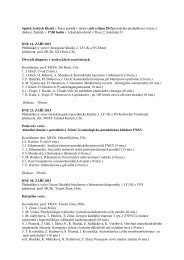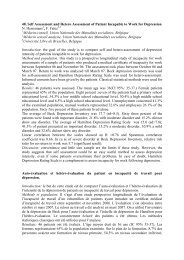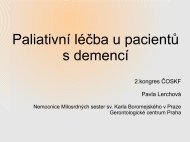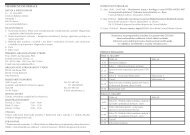ABSTRACTS â ORAL PRESENTATIONS - AMCA, spol. s r.o.
ABSTRACTS â ORAL PRESENTATIONS - AMCA, spol. s r.o.
ABSTRACTS â ORAL PRESENTATIONS - AMCA, spol. s r.o.
You also want an ePaper? Increase the reach of your titles
YUMPU automatically turns print PDFs into web optimized ePapers that Google loves.
cells (LSC) are present in CD45+34+38-26+ subpopulation only. Loss of expression of<br />
CD26 on Ph - cells from patients with pattern 2 appears to be specific for after-therapy<br />
phase of the disease. On the other hand, not all CD45 + 34 + 38 - 26 + cells were found Ph<br />
positive.<br />
Our findings confirm that CD26 antigen is useful for discrimination between Ph + and<br />
Ph - cells in exact disease phase and/or pattern-dependent only. However, considering<br />
easy identification of chronic myeloid stem cells by Ph positivity in CD45 + 34 + 38 - 26 - or<br />
CD45 + 34 + 38 - 26 + populations, it is obvious that precise separation LSC from HSC in target<br />
populations using CD26 is not possible in all settings. Despite these facts, this approach<br />
opens up a new possibilities for CML study.<br />
Acknowledgements<br />
Supported by MH CZ - DRO (FNBr, 65269705)<br />
References<br />
Gerber JM, Gucwa JL, Esopi D, Gurel M, Haffner MC, Vala M, Nelson WG, Jones RJ,<br />
Yegnasubramanian S.: Genome-wide comparison of the transcriptomes of highly<br />
enriched normal and chronic myeloid leukemia stem and progenitor cell populations.<br />
Oncotarget. 2013<br />
Janssen JJ, Deenik W, Smolders KG, van Kuijk BJ, Pouwels W, Kelder A, Cornelissen JJ,<br />
Schuurhuis GJ, Ossenkoppele GJ.: Residual normal stem cells can be detected in newly<br />
diagnosed chronic myeloid leukemia patients by a new flow cytometric approach and<br />
predict for optimal response to imatinib. Leukemia 2012<br />
64. EPITHELIAL-TO-MESENCHYMAL TRANSITION IN SUBPOPULATION OF MOUSE<br />
PROSTATE STEM CELLS AND CANCER STEM-LIKE CELLS<br />
Zuzana Pernicová 1,2 , Eva Slabáková 1,2 , Radek Fedr 1 , Maximilian Marhold 3 , Erwin<br />
Tomasich 3 , Peter Horak 3 , Alois Kozubík 1,4 , Karel Souček 1,2<br />
1<br />
Department of Cytokinetics, Institute of Biophysics, Academy of Sciences of the Czech<br />
Republic, Brno, Czech Republic; E-mail: pernicova@ibp.cz<br />
2<br />
Center of Biomolecular and Cellular Engineering, International Clinical Research Center,<br />
St. Anne‘s University Hospital Brno, Brno, Czech Republic<br />
3<br />
Department of Internal Medicine I – Oncology, Comprehensive Cancer Center, Medical<br />
University of Vienna, Wien, Austria<br />
4<br />
Department of Experimental Biology, Faculty of Sciences, Masaryk University, Brno,<br />
Czech Republic<br />
Epithelial-to-mesenchymal transition (EMT) is an important process during<br />
embryogenesis, which may be re-activated in several pathophysiological processes<br />
including tumor progression. In several models, normal cells or cancer cells undergoing<br />
EMT display properties and characteristics of stem cells (Kong et al., 2011; Mani et al.,<br />
2008). In our work, we aimed to identify EMT transcription factors with altered expression<br />
in subpopulation of mouse prostate stem cells or cancer stem cells, respectively, to prove<br />
involvement of EMT in biology of stem cells also in mouse prostate. There are several<br />
Analytical Cytometry VII 81








